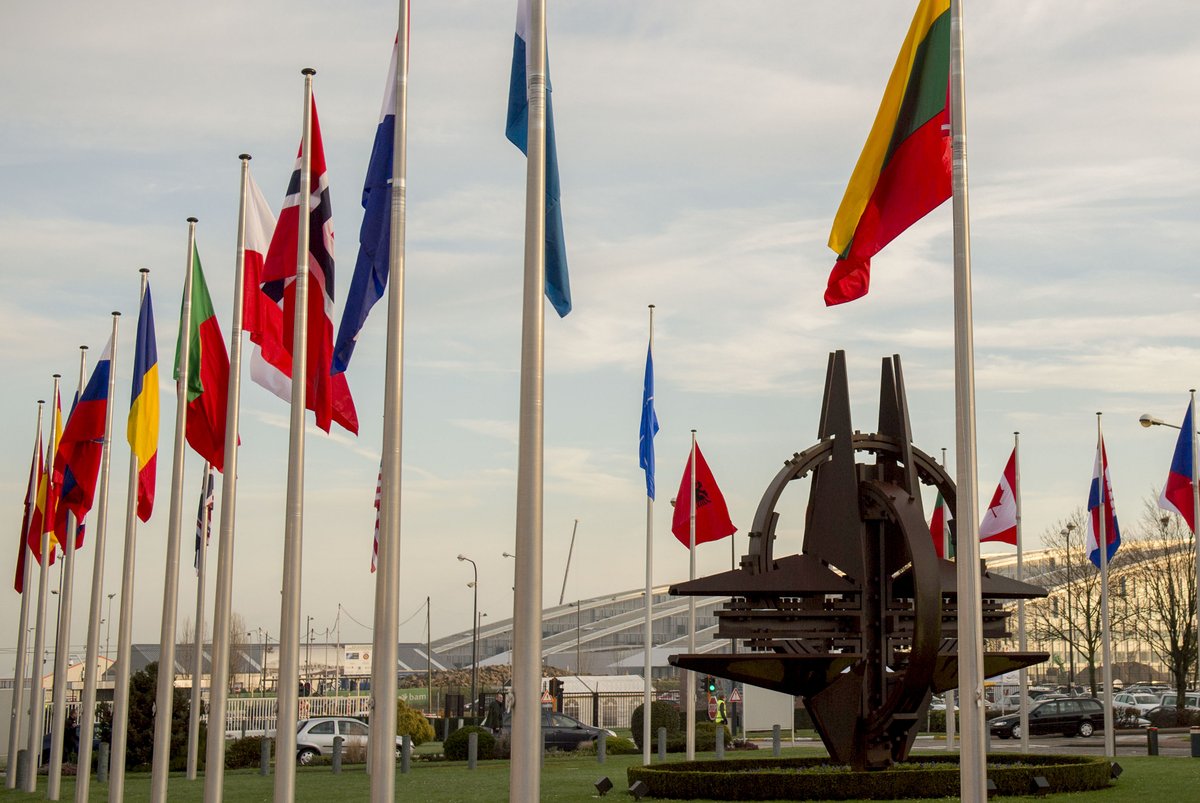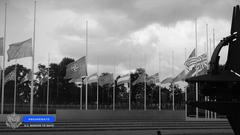
NATO Star Brussels Visiting Guide: Tickets, Hours, and Tips
Date: 14/06/2025
Introduction: The NATO Star in Brussels—History and Significance
Set at the gateway of international diplomacy, the NATO Star sculpture in Brussels, Belgium, stands as a potent symbol of unity, peace, and transatlantic cooperation. Located at the entrance of NATO Headquarters, this monumental artwork embodies the alliance’s enduring mission and storied legacy. Designed by Belgian architect Raymond Huyberechts and unveiled in the early 1970s, the NATO Star features a four-pointed compass rose and interlocking rings, representing the cardinal directions and the deep connection between Europe and North America. Its factory-oxidized steel construction, with a distinctive red-brown patina, reflects both NATO’s resilience and the timelessness of its values (NATO official site; Espionart).
The sculpture is freely accessible outdoors, 24/7, at Boulevard Léopold III. While entry to the NATO Headquarters itself is restricted, the NATO Star is easily viewed and photographed from public vantage points. Situated in Brussels’ Haren district—a hub for international institutions—the site is well-served by public transport, and proximity to attractions like the Atomium, Mini-Europe, and the Royal Greenhouses of Laeken makes it an ideal stop on any Brussels itinerary (Wikipedia; visit.brussels).
This guide covers the NATO Star’s history, symbolism, visiting hours, accessibility, practical travel tips, and recommended nearby attractions. Whether you’re a history enthusiast, art lover, or casual traveler, understanding the significance of the NATO Star will enrich your Brussels visit. For the latest updates, tour opportunities, and personalized planning, consult official sources and consider using the Audiala app (NATO visitor information; Visit Brussels).
Contents
- Introduction
- Origins of the NATO Star Sculpture
- Symbolism Embedded in the Design
- Historical Context: Cold War and NATO’s Identity
- The Mystery and Attribution of the Sculpture
- Visiting the NATO Star: Practical Information
- Location, Accessibility, and Visitor Tips
- Essential Visitor Information
- Nearby Attractions
- Complementary Experiences in Brussels
- Suggested Itineraries
- FAQs
- Visuals and Media
- Additional Resources
- Conclusion & Recommendations
- Sources
Origins of the NATO Star Sculpture
Commissioned in the early 1970s during the Cold War, the NATO Star was conceived as a three-dimensional interpretation of NATO’s emblem. Raymond Huyberechts, the Belgian architect behind the design, modeled the sculpture after the “rose des vents” (compass rose), a universal symbol of direction and unity (NATO official site). The use of factory-oxidized steel allows the sculpture to withstand Brussels’ weather and develop a striking patina.
Installed in 1971, the NATO Star was moved to the new headquarters in 2016, remaining at the heart of NATO’s identity (Espionart).
Symbolism Embedded in the Design
The Four-Pointed Star:
Representing the cardinal directions, the star alludes to NATO’s commitment to collective defense, vigilance, and peace in every direction (Espionart).
The Circles:
Two interlocking rings encircle the star, symbolizing the unity and continuity of NATO’s transatlantic bond between Europe and North America (NATO official site).
Material and Color:
The oxidized steel underscores strength and permanence. Its red-brown patina is timeless, while the original blue backdrop—now replaced by the open Brussels sky—once symbolized the Atlantic Ocean (Espionart).
Historical Context: Cold War and NATO’s Identity
Unveiled amid Cold War tensions, the sculpture was designed as a neutral, easily recognizable emblem, avoiding specific national or military imagery to underscore unity and peace (Espionart).
The Mystery and Attribution of the Sculpture
For decades, the NATO Star’s authorship was uncertain. Only after its relocation in 2016 was Raymond Huyberechts officially credited as the creator (Espionart).
Visiting the NATO Star: Practical Information
Visiting Hours & Tickets:
The NATO Star is outdoors and freely accessible 24/7; no tickets or reservations are required.
Getting There:
- Metro: The closest metro is Heysel/Heizel (Line 6), about a 10-minute walk.
- Bus: Lines 12, 21, 65, and 80 stop at “NATO,” adjacent to the headquarters (visit.brussels).
- Train: Brussels-North is the nearest major station, connecting to local buses.
- Airport: Brussels Airport is only 5 km away, accessible via Bus 12.
Accessibility:
The surrounding area is wheelchair accessible, and public transport offers step-free access. For special arrangements, contact NATO visitor services in advance.
Security:
The sculpture is visible from Boulevard Léopold III and public spaces near the main entrance. Close-up access inside the security perimeter is limited to special events or guided tours arranged in advance (Wikipedia).
Parking:
Limited and generally reserved. Public transport is recommended.
Location, Accessibility, and Visitor Tips
- Address: Boulevard Léopold III, 1110 Brussels, Belgium (Wikipedia; State Magazine)
- Best Viewing Points: Public areas along Boulevard Léopold III and the adjacent bus stops.
- Photography: Allowed from public areas; avoid photographing security staff or restricted facilities.
- When to Visit: Daylight hours are best for photos. The area is busiest on weekdays; visit during off-peak times for a quieter experience.
- Language: French, Dutch, and English are widely spoken (Happy to Wander).
Essential Visitor Information
| Mode of Transport | Details | Notes |
|---|---|---|
| Train | Brussels-North station | Connects to buses/taxis |
| Metro | Heysel/Heizel (Line 6) | 10 min walk |
| Bus | Lines 12, 21, 65, 80 | “NATO” stop adjacent |
| Car | R0/E40 | Limited parking, security checks |
| Airport | Brussels Airport | 15 min by bus or taxi |
Tourist Help: Brussels Info Place (BIP), Rue Royale 2-4, 1000 Brussels
Nearby Attractions
- Atomium: Atomium – Modernist icon offering panoramic city views (Full Suitcase).
- Mini-Europe: Mini-Europe – Miniature park with models of Europe’s landmarks.
- Royal Greenhouses of Laeken: Royal Greenhouses – Open each spring; booking recommended.
- Parc de Laeken & Japanese Tower: Parc de Laeken; Japanese Tower.
- Brussels Expo: Brussels Expo – Venue for international fairs and concerts.
Complementary Experiences in Brussels
- Guided European Quarter Tours: Explore the political core of Brussels (European Quarter; Nomadic Matt).
- Museum of Natural Sciences: Museum site – Features extensive dinosaur galleries and interactive exhibits.
- Belgian Beer Tastings: Beer tasting tours – Explore Brussels’ brewing heritage.
- Culinary Hotspots: Sample moules-frites, waffles, and chocolates (Visit Brussels).
- Parks: Cinquantenaire Park – Ideal for walks and summer festivals.
- Architecture Walks: Brussels Art Deco – Guided or self-guided tours.
- Shopping: Les Galeries Royales Saint-Hubert – Historic shopping arcade.
- Festivals: Ommegang; Brosella Festival.
- Family Activities: Atomium, Mini-Europe, and Royal Greenhouses, plus playgrounds and discounted passes (Brussels Card).
Suggested Itineraries
- Half-Day: Atomium and Mini-Europe, stroll in Parc de Laeken, photo at the Japanese Tower.
- Full Day: Add a European Quarter tour and the Museum of Natural Sciences, end with local cuisine.
- Family Day: Mini-Europe in the morning, Atomium lunch, Royal Greenhouses in the afternoon (seasonal).
Frequently Asked Questions (FAQ)
Q: What are the NATO Star visiting hours?
A: The sculpture is outdoors and accessible 24/7.
Q: Is there an entry fee?
A: No, it’s free to visit.
Q: Can I tour NATO Headquarters?
A: Public tours are generally not available. Access is limited to special events with advance registration.
Q: Is the area accessible for visitors with mobility challenges?
A: Yes, the area and public transport are wheelchair accessible.
Q: How do I get from Brussels Airport?
A: Use Bus 12 for a direct connection.
Q: What nearby attractions are recommended?
A: Atomium, Mini-Europe, Royal Greenhouses, Parc de Laeken, and the European Quarter.
Visuals and Media
- Include photos of the NATO Star with alt text: “NATO Star sculpture at Brussels headquarters.”
- Embed a map showing the NATO Star’s proximity to Heysel Metro station and Brussels landmarks.
- For virtual tours and official images: NATO Virtual Tour.
Additional Resources
- Visit Brussels – Official event listings, maps, and visitor info.
- NATO Visitor Information – For special events and tours.
- Brussels Info Place (BIP) – Tourist info, Rue Royale 2-4, 1000 Brussels.
Conclusion & Visitor Recommendations
The NATO Star in Brussels is much more than a striking sculpture—it is an enduring emblem of international unity, peace, and collective defense. Its outdoor placement ensures all visitors can appreciate its design and meaning, even if close-up access inside NATO Headquarters is limited (Espionart; Wikipedia). Surrounded by some of Brussels’ most significant attractions and easily accessible, it is a must-see for anyone interested in art, diplomacy, or European history.
To maximize your visit, plan ahead using official tourism resources, check for special events, and consider the Audiala app for real-time updates and personalized itineraries. Experience the NATO Star, gain insight into NATO’s global role, and explore the vibrant city of Brussels.




































































































































